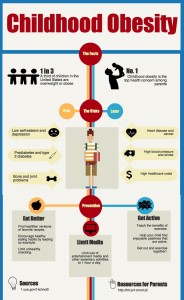
My infographic aims to educate parents about the growing rate of childhood obesity, health risks associated with the condition, and mechanisms for prevention.
Why an infographic?
Infographics are a growing trend in public relations. They are a great way to convey important information in an engaging format. In a world where people are becoming less and less interested in reading a page-long article, infographics communicate messages through design and, when used effectively, can prompt action.
Creating an infographic requires balance, patience and creativity. Through the process, I learned a lot about what you should and shouldn’t do to capture your audience’s attention. I’m excited to share what I learned; the five “do’s and don’ts” of infographic design.
Don’t overwhelm the viewer.
Infographics require a delicate balance between exciting design and too much design. Limit yourself to no more than five colors and two fonts. If you think you might have too much on the page, you probably do.
Don’t be afraid to ask for help.
If you are new to graphic design, building an infographic from scratch might be overwhelming. As a beginner, consider using Piktochart or a different template-generator for your first infographic to learn the ropes. If you are committed to using InDesign, there are hundreds of online resources where experts give tips and advice. A quick Google search will point you to websites that can help with color swatches, graphs, images, and everything in between. For example, check out Kuler, a free tool that generates color swatches for InDesign.
Do research the topic.
A good infographic consolidates a topic and conveys only the “must know” information. Thoroughly research your topic across a variety of sources, so you can be sure that your infographic includes the best and most important information available.
Do have a plan.
Before you open Piktochart or InDesign, put some thought into the way you want your infographic to work. Look at examples of infographics for inspiration and then draw out a rough sketch of the way you want your infographic to look. Think about the overall feel of the message you want to convey and pick fonts and colors that match it.
Do be patient.
They didn’t build Rome in a day, and you probably won’t build your infographic in one either. Give yourself enough time to play around with different fonts, colors, images, and designs until you find the perfect ones. I recommend beginning your infographic at least a week before it is due to avoid frustration and create a product you can be proud of.


